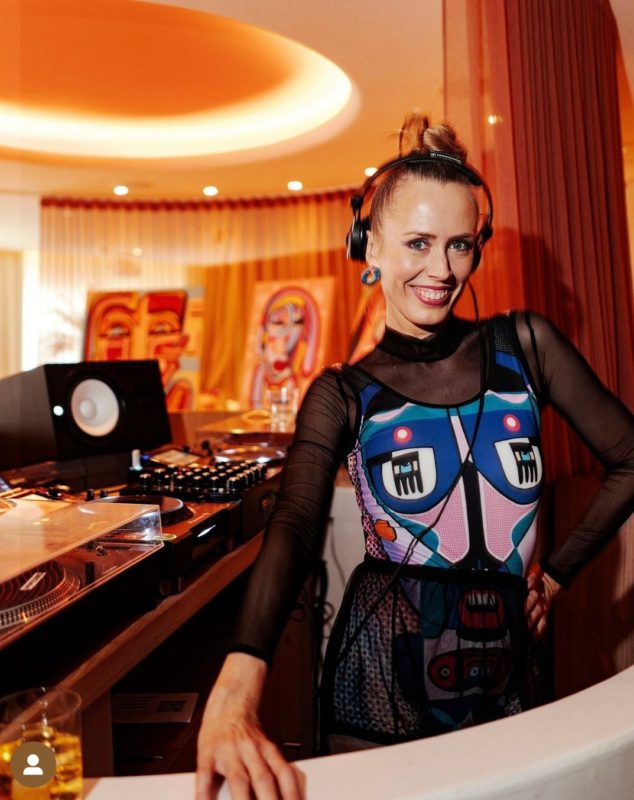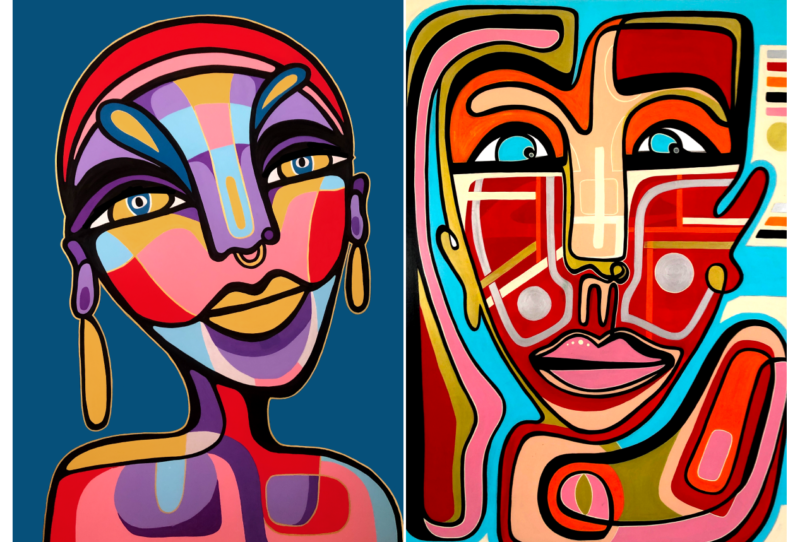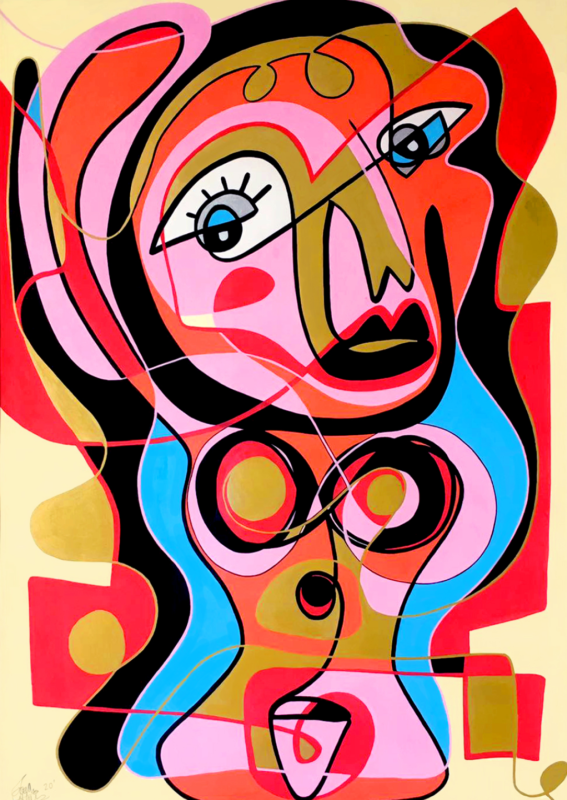In her art, Sarah Main blends traditional mediums with advanced technology. She experiments with augmented and virtual realities, AI, and is an active participant in the Web 3 community. From Australia, her passion for music took her to the vibrant shores of Ibiza where she spent several years as a DJ. Today, her focus is on painting and digital art. She also organizes contemporary art festivals that bring together various art forms.
Fine Art Shippers interviewed Sarah Main about her versatile journey, her pursuit of authenticity, her exploration of blockchain, and her thoughts on the democratization of art.
Artist Talk: Sarah Main on Web 3 and the Democratization of Art
Can you tell us about your journey from Sydney to becoming a DJ in Ibiza? What drew you to the world of electronic music and DJing?
Sarah Main: I grew up in a small town in Australia, not too far from Sydney. At 16, my house burned down. It was then that began painting for the first time, and it became my refuge. I painted every day throughout school and eventually pursued fine arts at Sydney University.
After moving to Sydney in the early nineties, I got acquainted with the booming house music scene. I started DJing and become quite successful, touring around Australia. Yet, always curious and seeking novelty, I eventually traveled to Ibiza in 1999. The island, with its thriving music scene and immense creative energy, captivated me. I was particularly drawn to a club called Pacha and set my sights on performing there. By 2001, my dream came true.

What did you find in Ibiza?
It was an amazing period. I kept painting in the background, although sporadically. I had a few exhibitions, but none gained significant attention. Everything changed when I had my son. He reshaped my perspective on life and made me rethink my priorities. After DJing at Pacha for a number of years, the music trends evolved, and I often felt I was playing music just to fit in with these trends, rather than staying true to my own style. But after becoming a mom, I realized I wanted to be genuine, both for myself and as a role model for my son. It was time to be authentic in everything I did.
What steps did you take to regain this authenticity?
Getting back to my real creative self took some time. I tried changing my music style, only playing what I truly enjoyed. But the passion I had for music in the early 2000s seemed to fade out. DJing kept going, but my heart wasn't fully in it. In search of clarity, I went on this intense week-long psychedelic retreat. But instead of finding answers, I left with even more questions. On top of that, I lost several gigs, which was a big financial blow.
I shared my concerns with my cousin who suggested I go back to art. I don't know why I hadn't thought of it before. I started doodling one-line drawings on my sister's blackboard in Barcelona, the city of Picasso. Sharing my sketches, I got some really encouraging feedback from my cousin. Soon, I was drawing on cardboard boxes and anything I could find as it was a Sunday. By Monday morning I was feeling so inspired, I decided to visit an art store to get a stock of paints and canvases. I worked non-stop for about six weeks, creating enough pieces for an exhibition, and soon had my own art show.
How did the events evolve after the exhibition?
After the show, I realized that art was my path forward, and DJing became a side gig. And it was perfect timing: when the pandemic hit, if I had still been mainly DJing, I’d have been in trouble. I also picked up another part-time job, knowing that my paintings might not sell right away. Of course, the pandemic shook things up, even making me think about going back to Australia. But it also opened other doors. I engaged in cryptocurrency, played around with augmented reality on my art pieces, and used AI to create new versions of my work.
Choosing to become a full-time artist wasn't an easy decision. I definitely had my moments of uncertainty. In 2021 when the pandemic restrictions were still in place, I organized an art festival in Girona. It was there that I created my first live-painted AR mural and introduced a virtual art gallery to reach a global audience. We had 4,000 people show up to the actual festival.

Please tell us about your experiments with Web 3.
After a period of searching, I came across Web 3 and instantly felt it was something that resonated with me. It was so different from the competitive environment of Web 2! I found myself in this amazing crypto community where we started to work on a decentralized music festival. Imagine a festival where everyone involved, from the audience to the artists, holds a share through tokens.
I also began creating art and music NFTs. Thanks to Web3, everything's clicking into place. My love for music, art, digital creation, and even animation can all coexist in this space. It's like all the different parts of my life are finally coming together in harmony.
For those who don’t know much about Web 3, could you explain how it operates and why creators like you find it so attractive?
Web3 is the next step in the evolution of the internet. Through blockchain technology, it gives people true ownership of their data and art. Today, platforms like Instagram technically own everything we post; if they shut down your account, you lose it all.

Beyond technology, what's truly remarkable about Web 3 is the community forming it. It’s very collaborative, respectful, and inclusive. Since the space is still young and experimental, everyone is working together to find best practices, there are no rigid rules.
For artists, Web 3 provides a global platform to showcase their work and gain support from an extensive and international community. Whereas in the traditional art world where artists may face high costs to exhibit their work, Web 3 democratizes the process. The artwork is uploaded to the blockchain and then listed in marketplaces for direct peer-to-peer sales. More importantly, artists can earn more royalties. For instance, if an artist sells a piece for $100 and later, as their reputation grows, the art is resold for $1 million, the creator would receive 10% of that resale value.
Another significant aspect of Web 3 is transparency. With every transaction recorded on the blockchain, there's no room for shady dealings. This fosters better behavior within the community. If someone acts inappropriately or unethically, the community will point it out.
Could you share some of your upcoming projects you look forward to?
I've got several exciting projects lined up. I'll be DJing at the Trevor Jones Castle Party in France in September, where I will be showcasing my AI visuals with my DJ set. Plus, I'm having my next offline exhibition in London in early October where I will exhibit my physical pieces layered with augmented reality and featuring a hologram guide who will speak to you about the meaning of each artwork. I’m also organizing a Web 3 music summit at the Amsterdam Dance Event in October, where we are gathering the best creative minds from the Web 3 music world and broadcasting live into the Metaverse. These are just some of the upcoming events I can share; there are many more plans in the works.
Interview by Inna Logunova
Photo courtesy of Sarah Main
